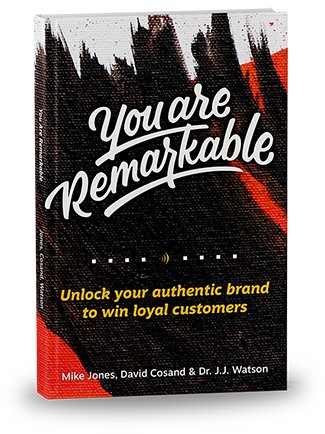Rebrands that work over the long term are all about character. You can dress up how you want, but how did that work for the rich kid who had awesome clothes and no friends? Let’s test that theory and contrast a wardrobe change and a lasting, effective rebrand. And we’ll add some bonus pre-branding disciplines that will get your organization ready to earn your rebrand.
“They just want the watch; they don’t want to know the time” -Cross Movement
Everyone knows that kid who dressed in expensive clothes, but just didn’t have the coolness or likeability to back it up. He wanted to be popular, but got convinced that he could buy popularity. The best ones figure it out and develop their social skills and their inner character, and have the best of all worlds: they look good, and they ARE good.
In business, we have the same phenomenon. It’s the foosball table, the kegerator, it’s bringing your pets to work day. It’s the boardroom, the Mac laptops (that every “creative” agency uses) and other things that you think make you legit. None of those things are bad, but if it’s not backed up by substance, it just seems poseurish and insincere.
In school, it was a kid named Tim (let’s just call him that, for conversation’s sake). He had all the soccer clothes and the best equipment. And he loved soccer. The problem was, he was only pretty good at soccer. In other words, with his outward commitment to soccer, you’d have expected so much more. But when I went out to play with him, he was good, but not in a way that added any value. I had other friends who were faster, stronger, more creative and just better people (at that age). And I think most people would have forgiven him if he were humble and a man of good character. But at that age, he just hadn’t put it together.
Many leaders give themselves a very low ceiling for growth, because they haven’t put it together. They’re naive enough to think that they’ve learned enough, that they’ve grown enough…that they’re mature enough.
What’s your ceiling? And how do you know your leadership can support a rebrand? Because even though it seems like it’s easier than making a personal life change, many executives find out that it’s not.
Some People Get It. Others Have to Fail.
Let’s face it. Growth is hard, and not a lot of people are praying to God for the kinds of trials that will put them onto the anvil and give them compassion and patience, along with balls of granite (an especially uncommon prayer for women, I imagine) and a spine of steel. Instead, everyone’s looking for the magic bullet; the business clickbait. “10 Ways to Grow Your Company Today.” Nobody wants to do the stuff you know you need to do, because it’s hard.
- Fire that guy (or group) who’s killing your culture.
- Bring your personality under control, so you can make a bigger impact.
- Pick a goal, tell everyone and hold everyone accountable to that goal.
- Live out the values your company says it holds to.
And unless life hands you a big, fat failure, most of us just keep doing the same unimaginative, stagnating activities, but calling it “strategy.” But there’s a cost.
It’ll Cost You
You’re a leader, but what if you were an employee? Would you fire yourself?
“The price of a bad hire is at least 30 percent of the employee’s first-year earnings.”
According to Forbes Magazine, recruiter Jörgen Sundberg estimates it costs $240,000 to onboard an employee. I’m assuming his average is a senior manager at a large company, and that your costs may be different. But still, according to the same article, the Department of Labor adds “the price of a bad hire is at least 30 percent of the employee’s first-year earnings.”
So what happens when the leader is the bad employee? What’s he costing the company? Surely it’s magnified when when it’s the leader. After all, they’re the ones who make people want to leave, which increases the cost of hiring (because it sucks to work in your organization), and cripples the quality and quantity of work.
Why A Rebrand Seems Easy
What if you hired an image consultant to change your look and behavior, but you didn’t change your character? You’d look and speak better, but nothing would have changed. You’d have the same personal and leadership problems, but with a new set of social skills. Your reputation wouldn’t change at all; worse, it may actually devolve as people see and hear you, setting their expectations high, only to watch you disappoint. Over and over again.
Many leaders think it’s easy to rebrand their company. Here are some reasons why.
You Don’t Need Discipline
You don’t have to exercise or change your diet, because people aren’t looking at you; they’re looking at the brand. Your logo, locations, website, etc all tell people what they need to know about your brand. So you don’t have to change your personal eating habits, and you don’t have to exercise.
But this is short-sighted, since true discipline starts on the inside. How long do you think people will trust your organization if you just made new promises without changing anything on the inside, including leadership’s commitment to fulfilling the brand promise?
Professionals Pick Out Your Wardrobe for You.
Your personal wardrobe is between you and maybe your significant other. But when you’re rebranding your company, other people pick out your look and feel; usually, they use information about your brand and then about your audience. And all you have to do is sign the check, right?
But who’s gonna execute in the day-to-day? Branding is meant to make that style a part of you…an extension of who you are…not just a temporary thing. You have to be able to execute over time, with the staff you have internally. Who’s your internal brand manager, and do they know how to make decisions about how to apply the brand? Do they have permission and confidence that comes from strong backing from leadership?
You Don’t Have to Learn Manners.
In your personal life, you can be whoever you want (just don’t do anything both bad and newsworthy, and you should be okay). You can refuse to tip your server, race through traffic like you’re the only one who matters and ignore people who need help.
But in company life, your earnings are related to how you treat people. In fact, the link between your earnings and how you treat your people is both indirect link and unavoidable. And this naive idea that we can treat the people around us in whatever abusive and disrespectful way we want, and it won’t show on the outside, will cost you real money.
Solution: Find out What’s Underneath the Clothes.
“You don’t always need a plan Bro. Sometimes you just need [guts].” -unknown
Everything seems easy when you’re only seeing the outside of the company. We think if we had Nike’s brand, we’d be like Nike. But that’s an illusion. Very few people have developed and shown the consistent character of leadership that Phil Knight has, in order to lead that organization and respond to challenges that have faced the company and the consequences of their decisions.
If you want to be like Nike, don’t think about a logo. Think about character. And there are some tried and true ways to develop character. There are things you can do on the outside that will set the table for your growth. And even though it has to happen on the inside, here are some ways to coax it along.
Vulnerability and Accountability.
- Get coaching from a professional coach who’s worked with people you respect.
- Find other, trusted relationships outside of the company and tell them you want to build character, no matter what it takes.
- In other words, find a way to get on the anvil so you can get hammered by people who love you.
Feedback.
- Do people you interact with feel respected at the company? Do they trust your character and believe you’re about the right things?
- Do people in the organization believe that you care less about everyone liking you and more about doing things rightly?
- Talk to people outside the company. Same questions.
Branding is Not Skin Deep. It’s Hard Core.
Remember that the best people in the world are disciplined and full of love. I’ve heard Navy SEALs talk about love being the fuel for why they fight. The CEOs of some of the biggest companies are some of the most disciplined people in the world.
Why does this matter? Because your ability to execute on anything your brand promises completely depends on your culture and processes. And those things all get their focus and discipline from the leader.
I don’t know where Tim is today, but I hope he’s built his look on a hardcore foundation of discipline and focus, having surrounded himself with people who possess traits that will help him grow. And if this is true, I hope he’s in a position of influence among his friends or as a leader of an organization. And I hope he’s taking it in a direction of true character. And instead of having to spend so much time, money and energy trying to bring empty promises (of good looks, abilities and character) together, that he’s sharing what he’s done, and causing others to grow.



